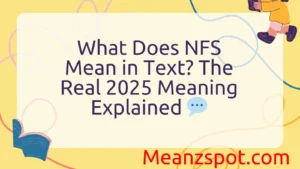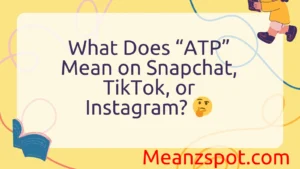In a world of nonstop texting, abbreviations and acronyms pop up everywhere. One that often leaves people scratching their heads is “FW.” Is it a typo? A secret code? Or does it stand for something you should already know?
As of 2025, the slang landscape keeps evolving—and FW is still trending across Snapchat, TikTok, iMessage, and even Twitter (or X). Understanding what it means can help you avoid awkward misunderstandings, especially since it can change based on the context. Whether you’re texting with friends, reacting to a viral post, or chatting in a group thread, knowing what FW stands for gives you a social edge.
In this article, we’ll break down the true meaning of “FW” in text messages, when and how to use it, and why it matters in today’s fast-paced digital talk. Let’s dive in so you’re never out of the loop.
Definitions & Meaning
The abbreviation “FW” typically stands for one of two meanings, depending on the context:
- Forward (in emails or messaging)
This is the most common and formal usage. When someone writes “FW:” in the subject line of an email or message, it signifies that the message has been forwarded from someone else. For example:- Subject: FW: Meeting Agenda for Monday
- Fck With (slang in texting or social media)**
In casual or informal settings, especially among younger audiences, “FW” can mean to “f**k with” someone or something. This can carry either a positive or negative connotation, depending on context:- I fw this song. (I really like this song.)
- I don’t fw him anymore. (I don’t associate with him anymore.)
It’s crucial to understand the tone and platform before interpreting “FW.” While it’s professional in an email, it’s often slang in texting or social apps.
Origins & History
The usage of “FW” can be traced back to two distinct origins—professional correspondence and internet slang.
- Professional Origin (Forward):
The term “FW” as a short form for “forward” emerged with the rise of email communication in the 1990s. Email platforms began using “FW:” in subject lines automatically when forwarding a message, making it a standard across many email clients like Outlook, Gmail, and Yahoo Mail. - Slang Origin (Fk With):**
The informal version developed later, likely in the early 2000s with the rise of SMS texting and instant messaging platforms like AIM, MSN, and eventually, social media platforms like Twitter and Instagram. In these contexts, users began shortening phrases to save characters and time, especially when character limits were in place (like Twitter’s original 140-character limit).
Today, both uses coexist, but the meaning largely depends on the medium and the audience. Younger demographics often associate “FW” with slang, while professionals will more likely see it as “forward.”
Usage in Different Contexts
Let’s explore how “FW” is used across various platforms and environments.
1. Social Media (Slang)
On platforms like Twitter, Instagram, TikTok, or Snapchat, “FW” is frequently used as slang. Examples:
- “I fw this new album—it’s fire 🔥.” (I really like this album.)
- “She’s real, that’s why I fw her.” (She’s authentic, and I respect her.)
Here, it usually implies approval, loyalty, or emotional connection.
2. Text Messaging (Casual Conversations)
In texts, “FW” retains a similar slang usage:
- “You fw him?” (Do you like or associate with him?)
- “Nah, I don’t fw that vibe.” (I’m not into that vibe.)
The tone can be playful, serious, or even dismissive depending on context and punctuation.
3. Emails & Professional Settings
In business or academic communication, “FW” nearly always means forward:
- “FW: Updated Budget Report”
- “Please see the FW email for meeting notes.”
It’s rarely used as slang in professional emails due to the risk of misinterpretation.
4. Pop Culture and Memes
“FW” often pops up in memes or viral content, especially when someone’s showing support or disdain for a trend:
- “Me fw this entire aesthetic 😍.”
- “When your dog fw you more than your friends do 🐶😂.”
These uses blend humor, emotional expression, and relatability.
Common Misunderstandings & Clarifications
Because “FW” has more than one meaning, confusion is common. Here are some common misconceptions:
- Assuming Professional Use in Casual Texts
- Misunderstanding: Someone reads “FW” in a text and thinks it means “forward.”
- Clarification: In texting or casual chats, it likely means “f**k with.”
- Reading Slang Meaning in Professional Emails
- Misunderstanding: A young reader sees “FW:” in an email and assumes it’s slang.
- Clarification: In email subject lines, “FW” always stands for “forward.”
- Assuming Negative Intent
- Misunderstanding: Thinking “I don’t fw you” is aggressive or threatening.
- Clarification: It could just mean someone is distancing themselves—not necessarily in a hostile way.
- Misreading Tone or Context
- Misunderstanding: Thinking someone is expressing affection when they’re being sarcastic.
- Clarification: Tone matters. “FW” can be ironic or serious depending on context.
Understanding the platform, audience, and tone is essential when interpreting “FW” accurately.
Alternatives & Synonyms
Depending on the intended meaning, several alternatives and synonyms can replace “FW” for clarity or tone adjustment:
If “FW” Means “Forward” (Professional Use):
- Forward
- FWD (also used in subject lines)
- Sent on behalf of
Example:
- FWD: Invoice for March
If “FW” Means “Fk With” (Slang Use):**
- Like
- Mess with
- Rock with
- Ride for
- Support
- Vibe with
Example Alternatives:
- “I mess with this track.”
- “I vibe with her energy.”
- “I really rock with that movie.”
Using these alternatives can help avoid confusion, especially in mixed-age or cross-cultural conversations.
Frequently Asked Questions (FAQ)
1. What does FW mean in texting?
In texting, “FW” usually means “f**k with,” indicating that someone likes, supports, or associates with someone or something.
2. What does FW mean in emails?
In emails, “FW” stands for “forward,” showing that the email content has been shared from someone else.
3. Is FW a bad word?
Not inherently. While the slang version implies a curse word, it’s often used casually and isn’t always offensive. However, be cautious about using it in formal settings.
4. Can FW be used in professional conversations?
Only when referring to “forward” in emails. Never use the slang version in professional contexts.
5. How can I tell which meaning of FW is being used?
Look at the context:
- Email subject? Likely “forward.”
- Text or Instagram caption? Likely slang.
- Is the tone professional or casual? This helps too.
6. Is FW the same as FWD?
They are similar but not identical. “FWD” is another abbreviation for “forward,” mainly used in older or non-English email clients.
7. Should I avoid using FW?
If you’re unsure of your audience or the context, it’s safer to use the full word (like “forward” or “vibe with”) to avoid confusion.
Conclusion
The abbreviation “FW” may be short, but it carries significant meaning depending on the context. Whether you’re forwarding an important business email or vibing with a new song on social media, understanding the dual definitions of “FW” ensures your communication remains clear and appropriate. In formal settings, “FW” means forward, signaling the sharing of information. In informal or social situations, it often means to fk with,** a slang expression denoting support, appreciation, or disapproval.
Misinterpreting “FW” can lead to confusion or awkward moments, so always consider the platform, audience, and tone. With the insights provided in this article, you’re now equipped to decode and use “FW” accurately—no matter where you see it.



